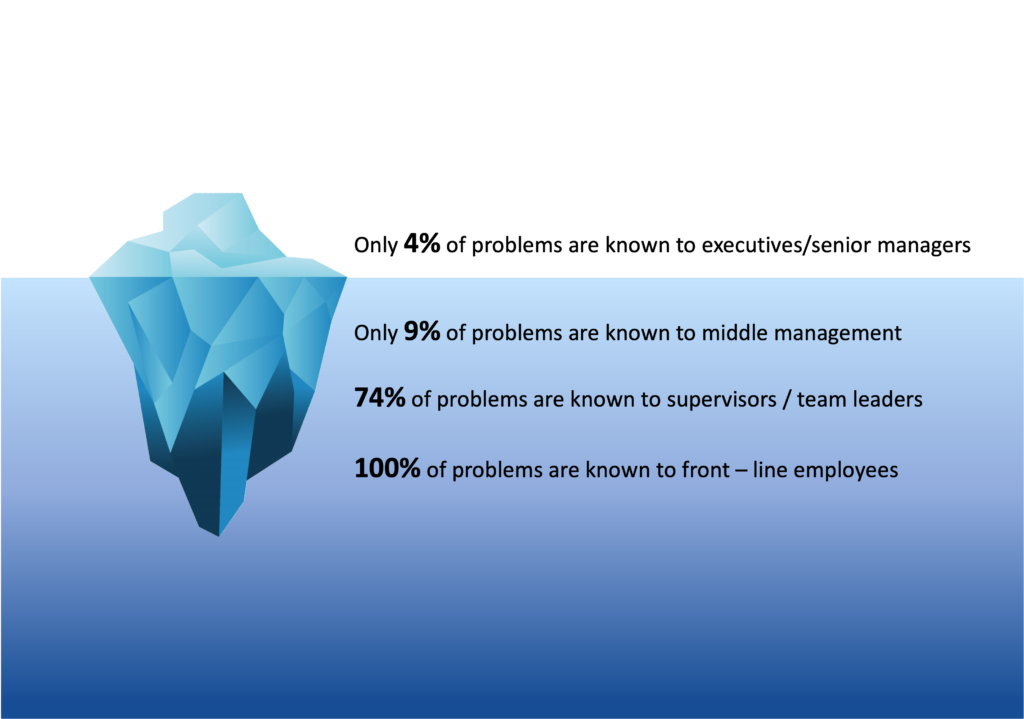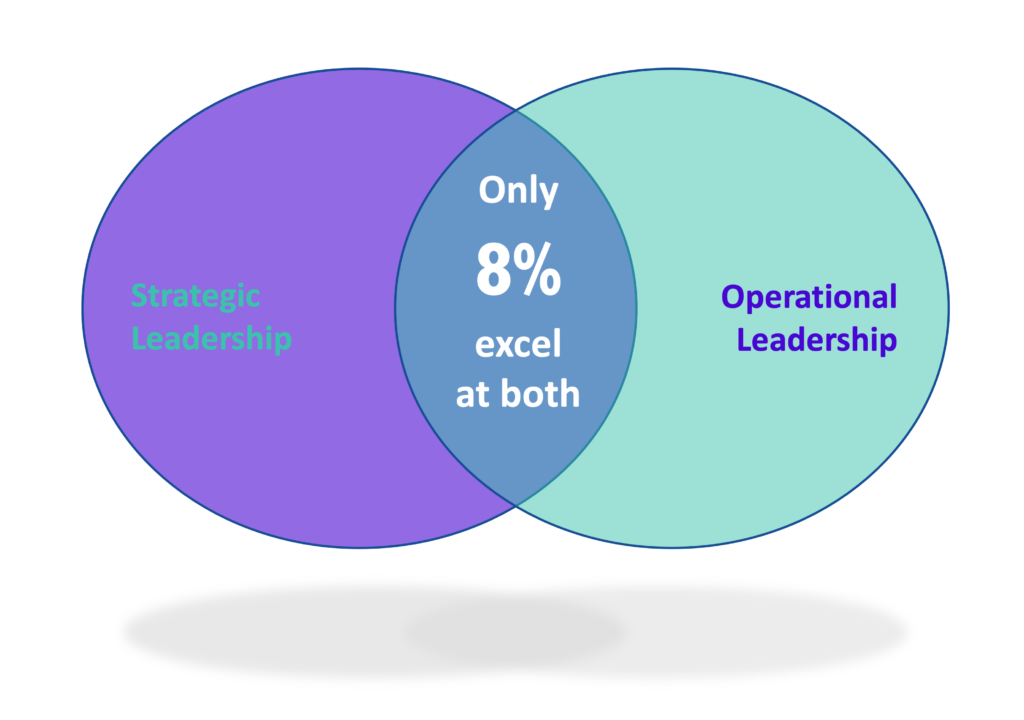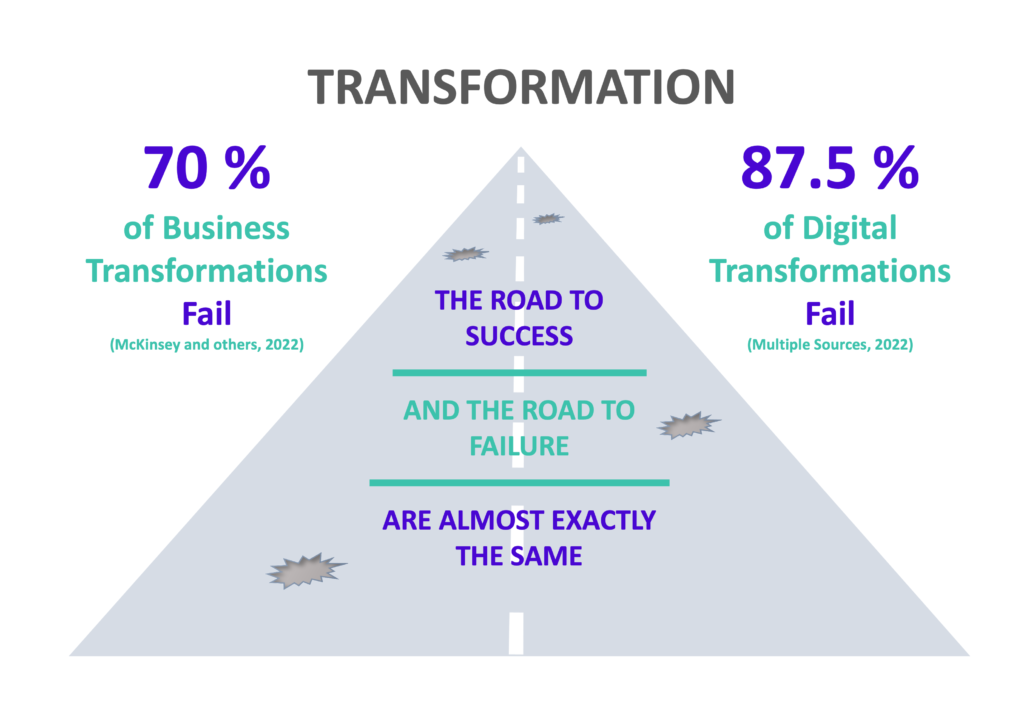Objectives can be as broad as an organisation delivering it’s global strategy or as narrow as a person completing a departmental task. However, regardless of the scale of the objective, there are common challenges in most organisations that work against the delivery of successful outcomes.
Visibility of problems

“The Iceberg of Ignorance”, based on extensive research by Sidney Yoshida, showed that typically, only 4% of an organisation’s problems are known to executives/senior managers.
Information that is critical to effective and timely decision making in organisations is often unintentionally held in “information silos” (e.g. at a departmental or project level).
Information that flows up to executives and managers is not only siloed in nature but is put together in a way that generally tells the best story possible.
Hence, key decisions are typically “after the event” decisions and therefore reactive (e.g. there is not enough budget or a significant issue has occurred).
What is missing is the relevant detail that shows the critical trends and insights (in and across silos) that enables improved data driven, “before the event” decision making – allowing the “course correction” that may be required to ensure objectives are met.
Leadership focus

“Vision without action is a daydream.
Action without vision is a nightmare.”
– a Japanese proverb –
A 2015 Harvard Business Review article by P Leinwand, C Mainardi and A Kleiner stated that only 8% of leaders are effective at both creating good strategies and executing them.
This suggests that “strategy to execution” requires collaboration between two types of leadership. Given the “Iceberg of Ignorance” challenges, it can be seen that it is critical to have effective, complete, and where necessary detailed, information exchange between those focused on Strategic Leadership and those focused on Operational Leadership.
In our experience information exchange, from those leading operations, programmes, projects, etc., to those leading strategy, tends to be siloed and partial. It is imperative that Strategic Leaders get complete, relevant, timely information from Operational Leaders that focuses on the decisions that need to be made to ensure successful delivery of strategy.
Strategy Execution

Respected business publications such as the Harvard Business Review, INSEAD, McKinsey and others indicate that between 50% – 70% of Strategies fail to deliver the expected outcomes. This does not mean that the Strategies were poor, but that their execution failed. While others have questioned the numbers, it is agreed that there is a problem.
Given that the potential consequences of failing to deliver a business strategy can range from the collapse of a business to restricted growth and a loss of stakeholder confidence, these numbers are concerning.
Much has also been written about the causes of strategy execution failure and we have mentioned some above. Other causes include: poor communication; cultural resistance; ineffective objective setting and poor objectives delivery; poor planning; poor scope change control; a lack execution speed; knowing what to measure and ineffective monitoring of progress; a lack of experience; insufficient bandwidth and poor governance. Quidita’s solution to these challenges is both comprehensive and compelling.
Transformation

A Transformation can be regarded as a Strategy or a component of Strategy, depending on the scope of the Transformation. However it should have a well formed execution plan, an appropriate budget and be resourced to deliver the plan – all the “common sense” things that should be in place.
Transformation failure rates are quote by many as being in the region of 70%, and a study in the Harvard Business Review in 2022 stated that the average failure rate of Digital Transformations (DT) specifically is 87.5%.
A 2021 report by Grand-View-Research indicated that the DT market is worth £14.4B in the UK, meaning that over £10B has been wasted by UK organisations.
The reasons for Transformation failure include all that we have mentioned above. At this level we would add poor/no effective change management and poor risk management.
Audits and reviews

Audits (be they internal or external audits, regulatory or compliance reviews or a project or programme health check) are frustrating when an auditor returns to check on progress and finds that deficiencies or issues have not been suitably addressed.
A suboptimal response to an audit means that improvement opportunities are missed and at worst, can put the organisation at risk of significant financial liability or even closure (e.g. health and safety audit failings that are not addressed and result in a loss of life).
Managers give many reasons for why they have not addressed audit findings in a positive and expected manner. Disagreement with some/all of the audit findings is one reason, others include a lack of clarity on what needs to be done to resolve an issue/deficiency and also that there are not enough resources to work on post audit actions.
Audits often point to some of the causes of Strategy to Execution failure. Hence ensuring that audit points are suitably addressed can have a positive impact on Strategy Execution.
Project Management

Project management remains a critical enabler of organisational change — but in today’s fast-paced and complex environment, traditional approaches often fall short. Methodologies and tools vary, but core challenges remain: fragmented visibility, unmanaged interdependencies, reactive risk management, and governance gaps.
The stakes are high. Despite significant investment in change initiatives, many organisations continue to suffer value leakage due to misaligned execution. A 2023 analysis by HSI found that in the U.S. alone, $122 million is lost for every $1 billion invested in projects due to ineffective project management. These figures highlight how poor delivery, unmanaged risks, and overlooked dependencies can derail strategic outcomes—especially in complex or fast-paced transformation environments.
Quidita addresses these challenges head-on with an integrated solution that elevates project management into a strategic capability. We focus on three critical — yet often underdeveloped — areas:
Dependency Management: We help organisations map and manage internal and external dependencies dynamically, reducing delivery risk and enabling agility.
Risk Management: Our approach moves beyond basic risk registers to embed real-time risk intelligence and escalation pathways into day-to-day delivery.
Governance: We modernise governance frameworks to be proportionate, adaptive, and aligned with executive oversight, without slowing down delivery.
As organisations shift from project delivery to outcome delivery, Quidita ensures that project management supports not just the execution of tasks — but the realisation of benefits.

